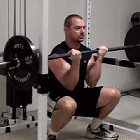 This is one of the best overall abdominal-and-core strength and stability exercises I’ve ever used. If you want a stronger core, this is the move to focus on.
This is one of the best overall abdominal-and-core strength and stability exercises I’ve ever used. If you want a stronger core, this is the move to focus on.
To perform the barbell curl-squat, all you really need is a barbell, but a squat rack will help in terms of execution.
Step in front of the bar and hold it in the top position of a barbell curl. Tighten your core, unrack the bar and step back. If you’re not using the rack, you can simply curl the weight up to the top position; however, that will limit the amount of weight you can use to what you can curl.
One of the most important form points here is to not allow your elbows to brace against your midsection. That will take away from the supporting tension on your abs. Set your feet fairly wide apart for balance and optimal stability. Now, holding the bar in that top curl position, squat as low as you can, and then come back up. (To be clear, you don’t actually curl the bar while doing the squat; you just hold it in the top curl position.)
Hold your breath during the bottom part of the movement to give your core greater stability—start holding it as you go below the halfway point and continue to hold it until you’re about halfway back up. If you don’t want to or are unable to hold your breath, exhale through pursed lips (as though you’re blowing up a balloon).
Holding your breath will, as stated, maximize core stability and allow your abs to stabilize more effectively during the movement. Since this exercise uses relatively light weight compared to a regular squat, holding your breath is not nearly as potentially dangerous. If you do feel light-headed, rack the bar and end the set.
Holding the resistance in front of your body, as you do in this exercise, eliminates the skeletal support that you would normally need in a front-squat-type movement. All the supporting tension goes directly onto the muscles of your core, which will have to contract hard throughout the entire movement in order to keep your torso from collapsing forward.
This exercise will help you to get a feel for using your abs during standard squats. It also helps to strengthen your abs greatly for that specific purpose, making this a very powerful core and overall strength-building exercise.
When doing barbell curl-squats for the first time, start with just the bar—no matter how strong you are—to learn the movement and setup. When you’re comfortable, work your way up in weight slowly, as fatigue will come quickly with this exercise. It’s a movement your body will be totally unused to, no matter how many abdominal exercises you’ve done in your training career before this. The muscles of the core will tire before your legs do.
If you’re able to, go all the way down until your elbows touch your knees. That will give you the fullest range of motion. Tense your abs hard, especially at the bottom, as you’re coming back up.
Holding the resistance in front of your body (as in a front squat) enables you to keep a more vertical body position. The tension will go to your abs, but beware that there will also be some tension on your lower back. Because you’re holding the weight out in front of you, the lower back must also contract to help stabilize your spine, so keep that in mind in terms of maintaining an arch in your lower back.
Another great benefit of this exercise is that your breathing muscles, the intercostals, never get a chance to fully relax. From top to bottom and back up—even while you’re “resting” at the top—your breathing muscles are being challenged because of the weight they are being forced to support. That can build up great breathing strength and carries directly over to your work capacity on regular barbell squats.
—Nick Nilsson
Editor’s note: To get a copy of Nick’s Muscle Explosion—28 Days to Maximum Mass, visit his Web site, www. 28DayMuscleExplosion.com.




















You must be logged in to post a comment Login